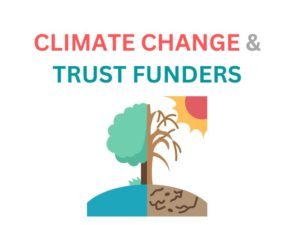Climate Change and Trust funders – part two
In our first part we took a look at the Funder Commitment on Climate Change and its implications on funders’ investment strategies. In Part two, we focus in on the second pledge of the Funder commitment: committing resources and ask is there more environmental funding available and what does it mean for charities?

We are starting to see a growing level of funds focused on the environment and climate change. Recent developments include:
- Lottery Funders – NLHF, ACE, Big Lottery, are ahead of most grant makers in environmental impact awareness and Summer 2022 has seen the launch of the National Lottery Climate Action Fund
- Government schemes – some administered direct by the Treasury, many by DEFRA or by agencies such as Natural England or the Forestry Commission. Local Authorities are another potential source of time limited funding pots
- There are a broadening set of companies whose activities have environmental impacts, who are looking to provide funding along the lines of Landfill Tax distributions (i.e. mitigation of harmful impacts). For example, the recent Powergen Environment Fund
- Commercial companies may be working through an acknowledged environmental body, e.g. Thrive Renewables promoting their funding through the Centre for Sustainable Energy.
Funders are increasingly asking to see environmental plans and policies as part of their application process with some, such as Arts Council England, even including environmental requirements in funding agreements.
So, who is going to be interested in this funding? There are newer environmental charities campaigning on climate change, as well as established nature and wildlife organisations who can make the case of the links between what they do and tackling the climate emergency. But there is also the potential for all charities to consider how their work does or could deliver climate action.
This is all very well, but what does this mean for your charity?
Implications for charities
- Environmental impact needs to be considered by every charity writing funding applications;
- At the least, DO NO HARM and demonstrate that;
- You will need to examine your client’s environmental credentials and resolve;
- When developing projects, include consultation on environmental issues, for example by contacting your local Climate Action Group.
The IoF’s Environmental Change toolkit for fundraisers is a useful starting point. It acknowledges “each charity will have different causes, capacity and resources” but says all charities can aim to
- Have the discussion at board level;
- Think seriously and strategically about divesting from fossil fuels (including in pension fund investments);
- Understand and measure your organisational carbon footprint;
- Set targets for reducing your carbon footprint (travel, energy, waste, carbon, etc);
- Publicly acknowledge the climate emergency and the action your charity is taking;
- Assess your gift / donation acceptance / direct mail policy with environmental factors in mind.
As the IOF says, doing nothing is no longer an option – whatever your organisation’s cause.
*
If you need help with researching funders or securing grants, Craigmyle Fundraising Consultants can help. Contact us today to discuss how we can support your organisation.





